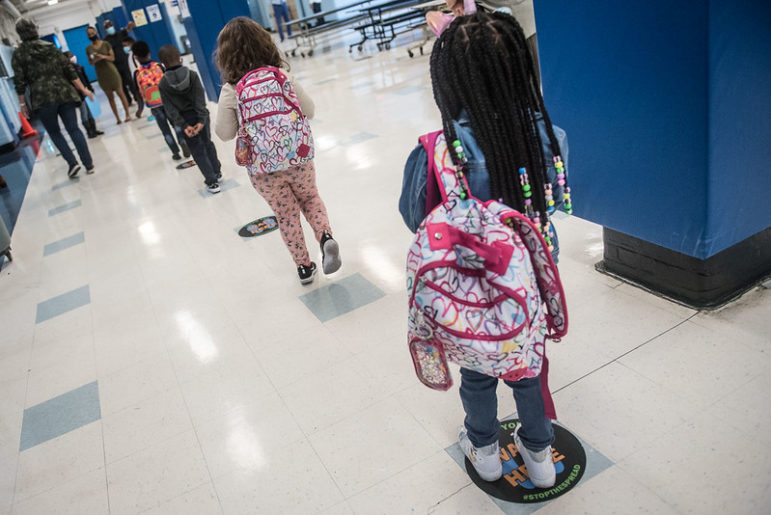‘Unless New York’s next mayor steps up to address the barrage of crises facing New York’s children, an already untenable situation is on track to become much, much worse.’

Michael Appleton/Mayoral Photography Office
A scene from the first day of school in September at Manhattan’s P.S. 188.It cannot be overstated how COVID-19 has devastated New York City’s children. As New Yorkers look towards the city’s reopening, tens of thousands of infants, children and teens are fighting to survive in the communities hit hardest by the pandemic, disproportionately represented by people of color. Every single day, children and their caregivers are grappling with the compounding trauma of systemic racism and its related outcomes, such as housing insecurity, hunger, life-altering mental health challenges, and the unrelenting cycle of poverty.
Unless New York’s next mayor steps up to address the barrage of crises facing New York’s children, an already untenable situation is on track to become much, much worse.
A recent data analysis from the Citizens’ Committee for Children lays bare how existing disparities in health, housing and income have only become more exaggerated during the pandemic, and reveal the cumulative and intersecting nature of risk factors threatening the lives of our city’s children—and the future of our city too.
Rising unemployment and job loss continue to deepen childhood poverty and hunger, housing insecurity and risk for homelessness; decreased engagement in well-child visits, immunization, and developmental supports result in declining child health and development; inequitable distance learning and learning loss widen the achievement gap. These threats to child well-being result in declining mental health, heightened risk of child welfare involvement as well as greater exposure to community-level violence.
In the most at-risk and hardest-hit communities, more than one in every three children live in poverty. In some of those neighborhoods, like University Heights, Morrisania, East Tremont, and the Lower East Side, that number is one in two. The rate of child hunger in New York City jumped from one in five to one in three in 2020. During that same time, more and more families drew closer to homelessness, as 66 percent of renters who are Black with children and 55 percent of renters who are Latinx with children reported a lack of confidence in meeting their next month’s rental payments. Meanwhile, Black and Latinx children experienced the loss of a parent or loved one at twice the rate of Asian or white children, all while social isolation increased and mental health needs skyrocketed.
Now, as current city leaders make final decisions on New York’s largest budget in history, we have an opportunity to invest in a comprehensive system of support and resources that New York’s children and families deserve. Decisive action must be taken to address the cumulative and compounding consequences of the current crises on children and their families, and to confront and uproot preexisting risk factors that have contributed to these sobering effects.
In the immediate term, how the city spends federal stimulus matters: year-round, full-day child care and youth services ensure kids reconnect with peers in supportive, age-appropriate settings and parents can get back to work; place-based behavioral healthcare in schools and communities reach children, adolescents, and caregivers addressing crisis level needs; increased housing voucher values will keep families out of shelters and in their homes; food supports embedded in services where kids and families naturally find themselves reduce hunger.
The next administration must build on crisis interventions being put in place now and focus on creating and sustaining investments that have proven to produce good outcomes—reducing poverty and promoting mobility, keeping families stably housed, achieving healthy child development and well being, achieving equitable education outcomes and supporting youth transitions to adulthood, and ensuring all communities benefit from essential infrastructure.
To these ends, the next mayor must deepen the local earned income tax credit and establish college savings options for every kindergartener; support universal access to affordable infant-toddler care and year round youth services, in addition to sustaining 3K and universal pre-K and offering a high-quality K-to-12 education for every child. Access to developmental supports and behavioral health services should be place-based from pediatric offices, to early care and education settings, school, afterschool and community settings.
Families also need access to affordable housing, and the communities within which they reside must be safe from over-policing and benefit from a very basic infrastructure of street lights, contiguous sidewalks, safe streets, and affordable transportation options, as well as access to affordable broadband access, food retail, banks, parks and playgrounds.
We must not be satisfied with a return to the state of inequity that existed prior to the pandemic. Combating racism and discrimination in all forms must be part of pandemic recovery efforts and result in uprooting long-standing barriers to child and family well-being.
When it comes to addressing New York’s long-standing inequalities, there’s no silver bullet. If we want all children to thrive, the building blocks for strong and healthy families have to be in place in every community. Given the traumatic impact the pandemic has wrought on New York’s children, the next Mayor must have the courage to invest in them as the success or failure of our children’s recovery and long term well being will define New York City’s future.
Jennifer March is the executive director of Citizens’ Committee For Children. (Editor’s note: CCC is a City Limits funder.)








